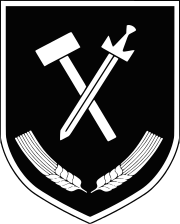This article relies largely or entirely on a single source .(December 2021) |
This article includes a list of references, related reading, or external links, but its sources remain unclear because it lacks inline citations .(January 2013) |
German Social Union Deutsch-Soziale Union | |
|---|---|
 | |
| President | Otto Strasser |
| Founded | 17 June 1956 |
| Dissolved | 25 May 1962 |
| Preceded by | Black Front (not legal predecessor) |
| Headquarters | Munich |
| Ideology | Strasserism |
| Political position | Far-right |
| Colours | Black |
| Anthem | "Volk, zu den Waffen!" ("Folk to Arms!") |
German Social Union (German : Deutsch-Soziale Union) was a political party founded in West Germany in 1956 by Otto Strasser, the founder of the Black Front. Founded after Strasser's return to Germany, it was dissolved in 1962.